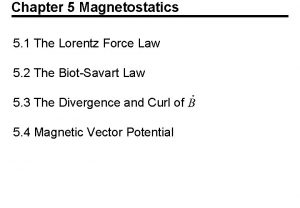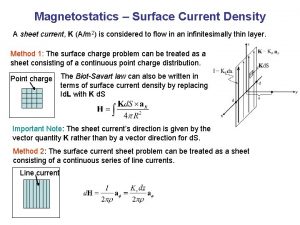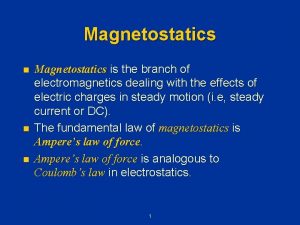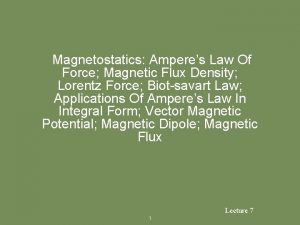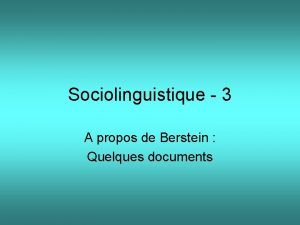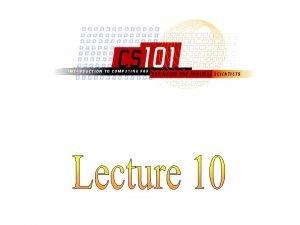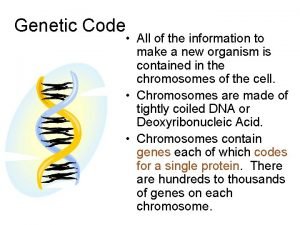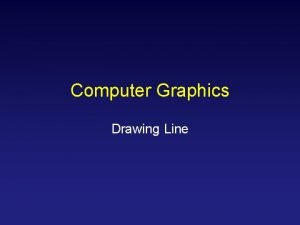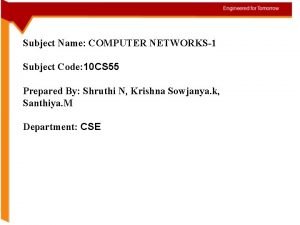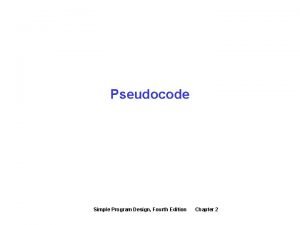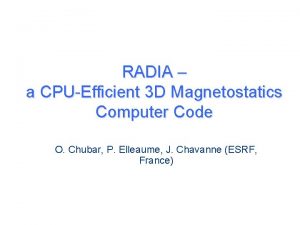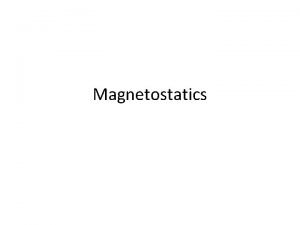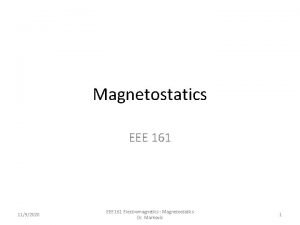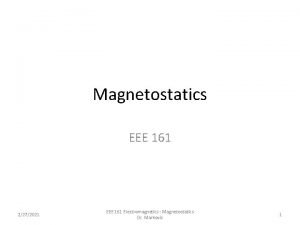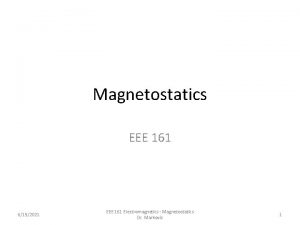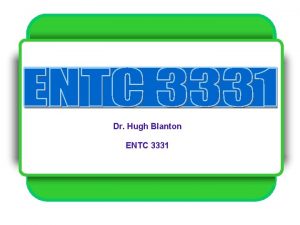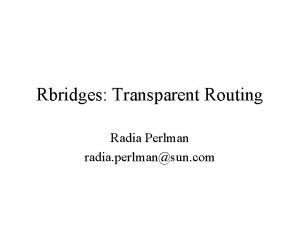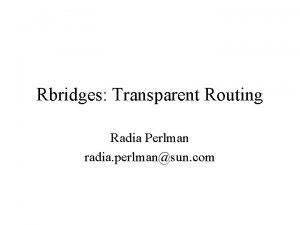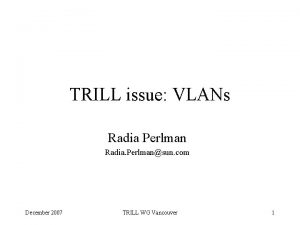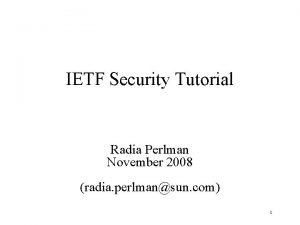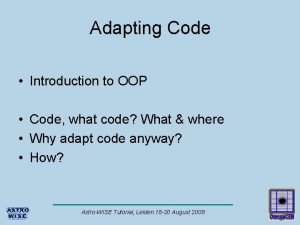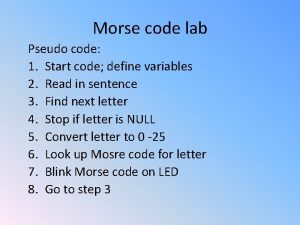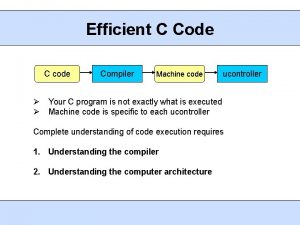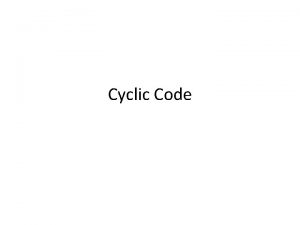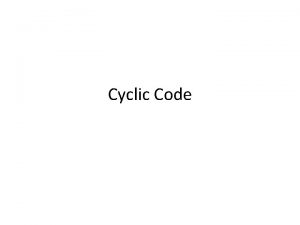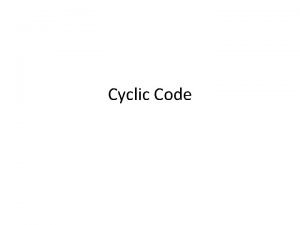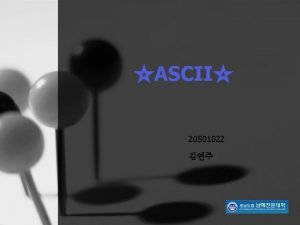RADIA a CPUEfficient 3 D Magnetostatics Computer Code
















![RADIA Examples Accelerator Magnets: SOLEIL Dipoles B [T] Central Field vs Longitudinal Position y RADIA Examples Accelerator Magnets: SOLEIL Dipoles B [T] Central Field vs Longitudinal Position y](https://slidetodoc.com/presentation_image/9ca048f90495cbb019d0954e1cbdba2a/image-17.jpg)












- Slides: 29

RADIA – a CPU-Efficient 3 D Magnetostatics Computer Code O. Chubar, P. Elleaume, J. Chavanne (ESRF, France)

Topics § § § Motivation Previous Codes Approach: Volume (/ Magnetization) Integrals Examples: Undulators, Accelerator Magnets, Inverse Problems Possible Evolution

Motivation H(r) SR e- Computation of stationary Magnetic Field produced by Permanent Magnets, Coils and Iron Blocks in 3 D space Optimized for the design of Insertion Devices (Undulators and Wigglers) for SR Sources, as well as Accelerator Magnets

Computer Codes Using Similar Approach Solving 3 D Magnetostatics Problems via Volume (/ Magnetization) Integrals – GFUN (Trowbridge et. al. , Rutherford Laboratory, 1970 s) – B 3 D (P. Elleaume, J. Chavanne, ESRF, 1989 -95) – RADIA (O. Chubar, P. Elleaume, J. Chavanne, ESRF, 1996 -…)

3 D Magnetostatics Magnetic Field created by Uniformly Magnetized Volumes Poisson equation for scalar magnetic potential: Solution through volume and surface integrals: Magnetic field created by uniformly magnetized volume:

3 D Magnetostatics Uniformly Magnetized Polyhedron Magnetic field: , s=1, 2, …, Ns , - coord. of vertex points of the face ns - external normal to the face Nf - number of faces (x 0, y 0, z 0) – coord. of observation point

3 D Magnetostatics Space Transformations and Symmetries Space Transformations V TV Symmetries (multiplicity m > 1) V TV T 3 V T 2 V Treatment of Symmetries reduces memory requirements and speeds up computation

3 D Magnetostatics Relaxation Interaction Matrix and Material Relations Relaxation Scheme Hi - total field strength in the center of object i Hex i - external field the center of the object i Mk - magnetization in the object k Qik - component of the Interaction Matrix (being itself a 3 x 3 matrix) fi(H) - magnetization vs. field strength law for the material of the object i - local susceptibility tensor for the material of the object i Mr i - remnantg magnetization in the object i for nonlinear isotropic material: This scheme is robust: no “relaxation parameter” required (!)

3 D Magnetostatics RADIA Implementation: C++ Main Classes 3 D Graphics Field Source Relaxation Space Transf. Permanent Coils Container Backgr. Field Relaxable “Rec. Mag. ” Extr. Polygon Polyhedron Material Nonlin. Isotr. Linear Unisotr. “Rec. Current”“Arc. Current”“Filament Cur. ” General Methods for Field Sources – – computation of Magnetic Field Strength, Vector Potential, Field Integral, Energy, Force, Torque subdivision (segmentation) RADIA is interfaced to: - Mathematica (Wolfram Research) - IGOR Pro (Wavemetrics) Exists on Windows, Linux, Mac OS platforms Available for download from ESRF and SOLEIL Web sites (Insertion Devices pages)

RADIA Examples APPLE-II PPM Undulator Circular/Elliptical Polarization Tilted Linear Polarization (parallel displacement of 2 magnet arrays) (anti-parallel displacement of 2 magnet arrays) Gap: 17 mm 0. 4 Bz 0. 2 B [T] 0. 2 Bx 0 0 0. 2 - 0. 4 0 20 40 60 s [mm] 80 Bz 0 Bx 20 40 60 s [mm] 80 Peak Field vs Shift bw Magnet Arrays B 0. 7 [T] 0. 6 Bz Bx Magnet Dimensions: 40 mm x 20 mm 0. 5 Mr = 1. 1 T 0. 4 0. 3 0. 2 0. 1 0 0. 5 A 1 B 1. 5 2 C 2. 5 3 D Invented by Sh. Sasaki et. al.

RADIA Examples Hybrid Undulator U 20 (SOLEIL) Optimization by C. Benabderrahmane

RADIA / SRW Examples Hybrid Wiggler 3 T Hybrid Wiggler Magnetic design by J. Chavanne, ESRF Magnetic Field and Electron Trajectory Spectrum vs Phot. Energy at diff. obs. points Magnets are designed using RADIA SR computations are using SRW Spectral Fux per Surface done. Unit vs Horizontal and Vertical Positions

RADIA Examples Electromagnet Elliptical Undulator HU 640 (SOLEIL) Pure coil structure (no iron parts) Consumed electrical power: ~100 k. W Vertical and Horizontal Magnetic Fields Magnetic design by O. Marcouille

RADIA Examples Electromagnet Elliptical Undulator HU 256 (SOLEILBINP) The Structure (A. Dael - P. Vobly) Magnetic Fields at Max. Currents (Radia) Iz max= 180 A, Ix max= 250 A Calculated Spectra at Maximal Currents Specifications: Circular Polar. : 1 min < 10 e. V Linear Hor. Polar. : 1 min < 10 e. V Linear Vert. Polar. : 1 min < 20 e. V Aperture: 0. 7 mr x 0. 7 mr

RADIA Examples: Fast-Switching Elliptical Undulator for XMCD Original design by J. Chavanne General Parameters Preliminary Design, derived from ESRF EMPHU u 65 mm; Lu 1. 6 m Min. gap: 16 mm Kx 1 max Kz 1 max 1. 5 Coils Imax < 300 A Conductor cross-section: 7 x 7 mm 2 Number of Layers: 8 Yoke Pole transv. size: 40 mm Pole longit. size: 12 mm Material: iron (laminated ) Permanent Magnets RADIA model with reduced number of periods (coil layer changes are not taken into account) On-Axis Magnetic Field Block dimensions: 30 x 17 x 15 mm 3 Transv. distance bw blocks: ~ 5 mm Material: Sm 2 Co 17 Magnetic Field “Roll-Off”

RADIA Examples Accelerator Magnets A B Edge Field (vs longitudinal position) Transverse Field low excit atio n A: dipole MAX-II B: quadrupole with Magne integrated ts sextupole component high excitat ion simulations by L-J. Lindgren Discrepancy between Radia simulations and measurements: < 1% (peak field)
![RADIA Examples Accelerator Magnets SOLEIL Dipoles B T Central Field vs Longitudinal Position y RADIA Examples Accelerator Magnets: SOLEIL Dipoles B [T] Central Field vs Longitudinal Position y](https://slidetodoc.com/presentation_image/9ca048f90495cbb019d0954e1cbdba2a/image-17.jpg)
RADIA Examples Accelerator Magnets: SOLEIL Dipoles B [T] Central Field vs Longitudinal Position y [mm] B [T] Edge Field vs Longitudinal Position y [mm]

Radia Examples Comparison with a commercial FEM Code Chamfer Optimization of ESRF Quadrupole simulation by J. Chavanne FLUX 3 D RADIA 200 000 Tetrahedrons 200 MB of Memory 3 Hours of CPU 1500 Polyhedrons 200 MB of Memory 1 Hour of CPU

Radia Examples Radia vs commercial FEM Code FLUX 3 D Hybrid Wiggler Simulation Comparison Case A: Solution for 1% accuracy in peak field Case B: Solution for 10 G-cm abs. accuracy in on-axis field integral * accuracy is high only in centers of 3 D elements

Radia Examples / Inverse Problems Sorting and Shimming Insertion Device Magnets Goals: Find optimal distribution of individual magnets (or magnet displacements) which would allow to compensate existing magnet imperfections and to reach required ID magnetic field characteristics Evaluation: Ordered Magnet Sequence(s) 12345678 54817263 Magnetic Measurements Data «Decoded on Individual Magnets (/ » Modules) Undulator & Partly Assembled Structure Undulator 1 3 5 7 5 4 8 1 7 2 6 3 2 4 6 Undulator Magnetic Field (/ Field Integrals) Characteristic Weight s s / Fitness Electron Terms Trajectory Straightness Radiation Phase Error Field Integral deviation from zero Integrated Multipoles RADIA 8 Mathematical Model / Total Field Calc. Method Fitnes s . . . Genetic Algorithms ID Magnet Sorting was pioneered by A. Cox and B. Youngman (1985) ID Magnet Shimming was pioneered at ESRF and ELETTRA (199 x) Possible Variation Operators for Permutations (i. e. for Sorting): Mutation : - e. g. swap magnets at two randomly chosen positions Crossover : - e. g. «order 1» - [12345678] [35681274] [54817263] [? ? ? 4567? ] [54617283] [81245673]

Shim Signatures of In-Vacuum Hybrid Undulator RADIA Model for Central Part U 20 RADIA Model for Extremities (A-, B- Modules and Poles) (E- Modules) Variation of On-Axis Field due to 25 m displacement of A-, B-, E-Modules and Poles Variation of Field Integrals due to 25 m displacement of A-, B-, E-Modules and Poles

“Spectral” Shimming of In-Vacuum Hybrid Undulator U 20 On-Axis Single-Electron Spectra Before and After Shimming (10 m from source) Evolution of 11 th Harmonic of Single-Electron Spectrum RMS Radiation Phase Error after Shimming ~2. 6 On-Axis Spectrum Taking into account E-Beam Emittance and Energy Spread x = 3. 7 nm; E/E = 10 -3

APPLE-II Undulator HU 80 -PLEIADES: Evolution of Electron Trajectory and Field Integrals (Min. Gap, Zero Phase) Horizontal Trajectory (Periodic Mode) Horizontal Trajectory (Quasi-Periodic Mode) Q. -P. Mode realized by 11 mm displacement of some Horizontal First Field Integral Vertical First Field Integral

RADIA “To. Do” List Short-Term Tasks - Simplifying definition of 3 D geometries, by importing files from CAD / 3 D meshing software (R. Carr) - Releasing RADIA for Python - Compiling and testing 64 -bit versions for Windows and Linux - Updating all existing versions for Windows, Linux and Mac OS - Updating RADIA distribution pages at SOLEIL web site Longer-Term Tasks - Further improving relaxation procedure (cases of many sub-volumes, non -linear mater. ) - Implementing coils / conductors with polygonal cross-section - Addressing inverse problems of 3 D magnetostatics (software for magnet sorting and shimming was the first step in this direction) - Implementing solvers of time-dependent direct problems (e. g. Eddy currents) - Supporting other similar direct problems of electrodynamics (e. g. electrostatics,

Acknowledgements J. -L. Laclare, J. -M. Filhol, D. Raoux O. Rudenko, A. Dael All Users of RADIA and SRW


In-Vacuum Hybrid Undulator U 20 (-SWING): GA-Based Module Sorting and Magic Finger Adjustment 97 full periods, 390 magnet Horizontal Field modules Vertical Field Integrals at 5. 5 mm Gap at 10 mm Gap

HU 80 Field Integrals at Minimal Gap (15. 5 mm) Horizontal Vertical TEMPO FOC (after extra shimming) PLEIADES

APPLE-II Undulator HU 80 - Foc: Extra Shimming to Reduce Multipoles Field Integrals at Minimal Gap and Different Phases Before Extra Shimming Vertical After Extra Shimming Horizontal After Extra Shimming Before Extra Shimming Phase-Dependent Normal Quad Variation Phase-Dependent Skew Quad Variation HU 80 - Foc was originally supplied by ELETTRA. Extra Shimming of the HU 80 - Foc was performed at SOLEIL. The Extra Shimming was based on Genetic Optimization and it took into account Phase-Dependent
 Cycloid motion in magnetostatics
Cycloid motion in magnetostatics Magnetostatics formula sheet
Magnetostatics formula sheet Fundamental laws of magnetostatics
Fundamental laws of magnetostatics Magnetic flux density vector
Magnetic flux density vector Oleon a natural chemistry
Oleon a natural chemistry Oleon a natural chemistry
Oleon a natural chemistry Hp radia
Hp radia Code commit code build code deploy
Code commit code build code deploy Code élaboré code restreint
Code élaboré code restreint Managed and unmanaged code
Managed and unmanaged code Code in assembly language
Code in assembly language Difference between source code and machine code
Difference between source code and machine code Code mixing
Code mixing Order of bases in dna
Order of bases in dna British computer society code of conduct
British computer society code of conduct Computer graphics drawing
Computer graphics drawing Little man computer multiplication
Little man computer multiplication Computer subject code
Computer subject code Computer organization subject code
Computer organization subject code Basic computer operations in pseudocode
Basic computer operations in pseudocode Any fool can write code that a computer can understand
Any fool can write code that a computer can understand 10 subject name
10 subject name Objectives of computer
Objectives of computer What is computer organization
What is computer organization The large program that controls how the cpu communicates
The large program that controls how the cpu communicates Basic structure of a computer
Basic structure of a computer Difference between computer architecture and organisation
Difference between computer architecture and organisation Basic computer design
Basic computer design Complete computer description in computer organization
Complete computer description in computer organization Ryb color code wound care
Ryb color code wound care
